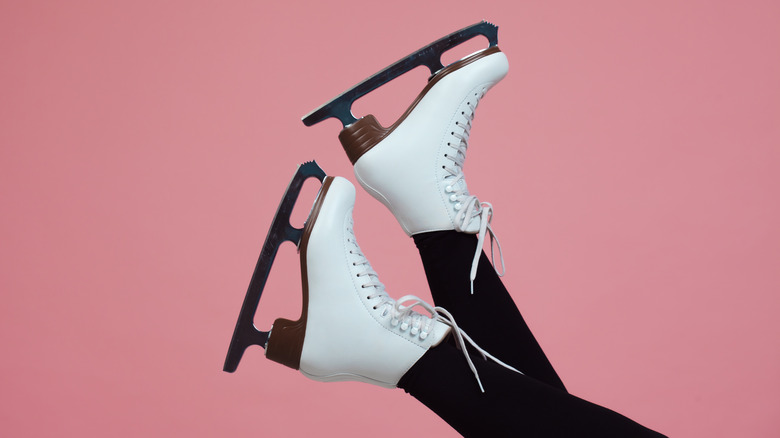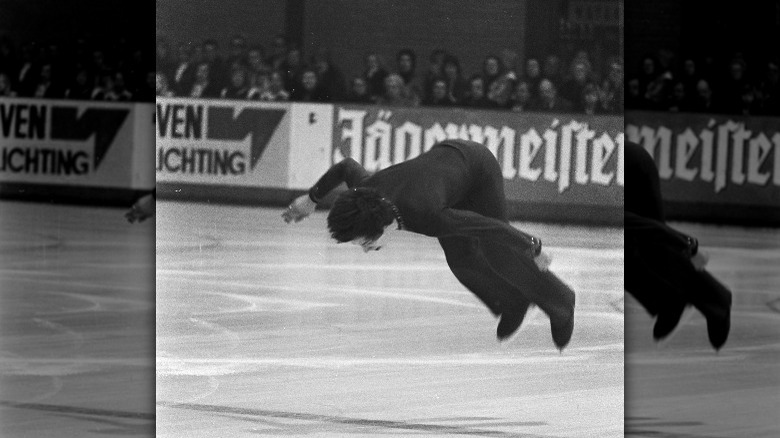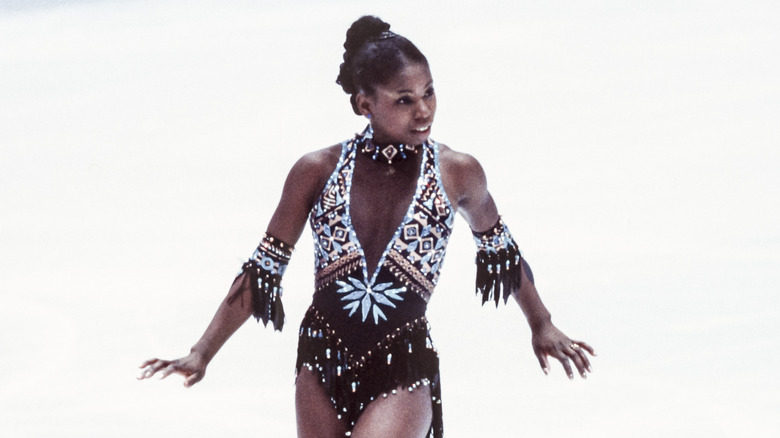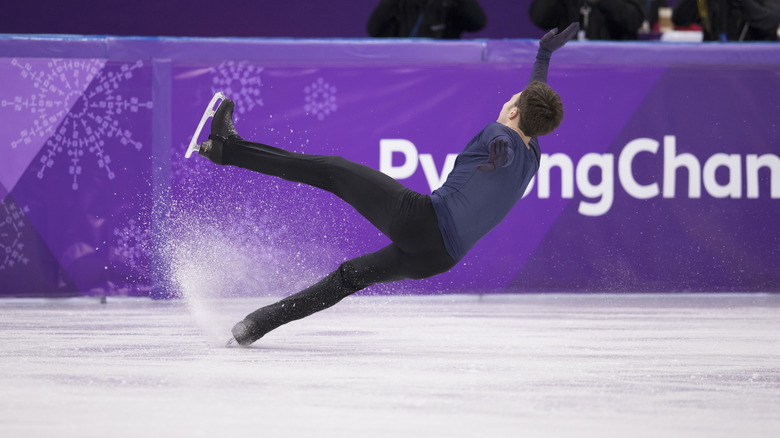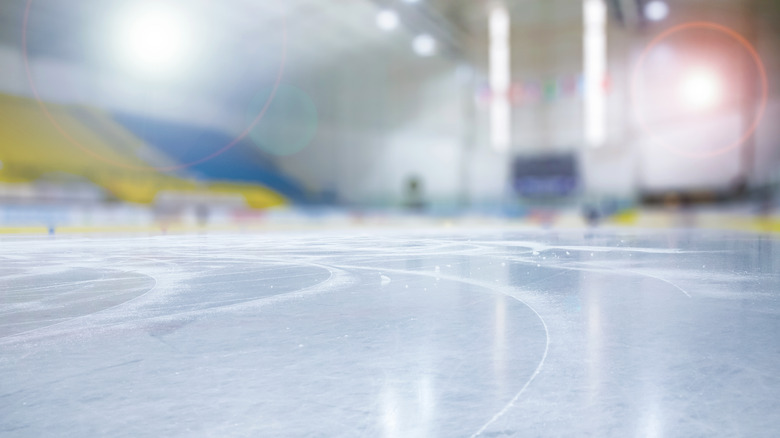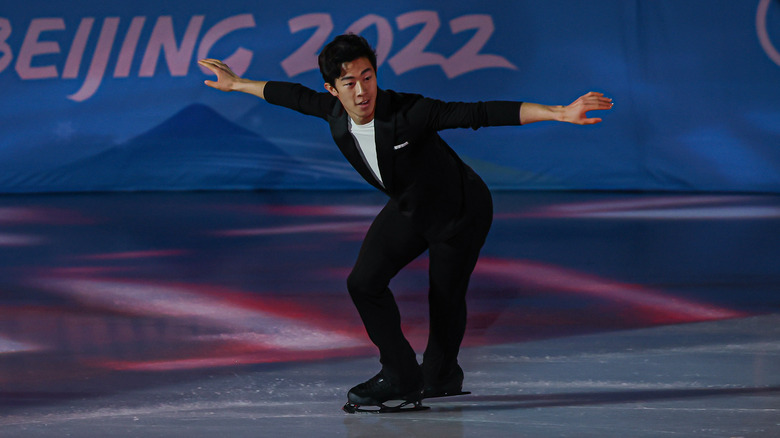The Biggest Theories Why Figure Skaters Are Banned From Performing Backflips
It seems like just about every event at the Winter Olympics is capable of making any onlooker think to themselves — even for just a fleeting moment — "This is very dangerous; someone should put a stop to this." Freestyle skiers and snowboarders launch themselves off ramps and halfpipes and soar through the air while spinning like the most whirling of dervishes. Skeleton competitors go full-speed down a track with their chins just inches above the ice. Even curling looks like it'd be really easy to slip while sweeping your brains out and find yourself sidelined with a pulled groin.
Still, figure skating glides under the danger radar. Perhaps it's the gracefulness, perhaps it's the pageantry, but for whatever reason, no one ever seems to talk about how dangerous figure skating is. Skaters have sharp blades strapped to their feet, then start spinning like human centrifuges so fast that even seasoned astronauts would need to reach for an air sickness bag. And helmets? Who needs 'em!
Even though skaters can lutz and toe loop until the salchows come home, according to Tyla, somersault jumps are banned from competition. This ban would include both front and backflips. But why? Out of all the seemingly death-defying spins and jumps that are not just allowed, but encouraged, why are backflips banned?
Were backflips ever legal in figure skating?
Technically, they were legal until 1976, but only no one had ever done one, at least not in Olympic competition. According to Slate, it was known ahead of the 1976 Winter Olympics in Innsbruck, Austria that Terry Kubicka (above) had a backflip in his bag of tricks, because he had already thrown one down in competition. That one came at the U.S. Figure Skating Championships one month before the games, and Kubicka managed to weave it into the end of his final skate of the competition, a trick which, according to an Associated Press article from the time, "brought the wildly cheering crowd to its feet even before the end of the performance." In fact, the Colorado Springs crowd got so loud that after landing his backflip, Kubicka couldn't even hear the music he was supposed to be performing along to.
Even before the competition started, Kubicka made it clear he planned to include the trick, which prompted questions about its legality. Kubicka himself said that as far as he knew it was legal, so he included it in his performance. It was the first and only legal backflip ever landed at the Olympics, but it only netted him a seventh-place finish.
Were backflips banned because one skater was so good at them?
A popular story about why the backflip was banned involves French skater Surya Bonaly. The story sometimes pops up ahead of a Winter Games, per Deadspin, and it alleges that Bonaly was the first and only skater to land a backflip in Olympic competition when she competed at the 1998 Winter Games in Nagano, and that she was so good at the trick that it was banned.
Bonaly was appearing in her third and final Olympics. While she had been a highly decorated skater throughout her career, she was nursing an injury in 1998 and wasn't expected to finish anywhere near the podium. The French skater was having a rough free skate performance which included a fall and other mistakes, so she decided to swing for the proverbial fences and launched into a backflip and flawlessly stuck the landing on one foot. While Bonaly's flip seemed to be a way to get the crowd on her side and cap off a strong career, it wasn't looked upon too kindly by the judges because it was, in fact, illegal.
The Bonaly story is easy to debunk because according to Slate, backflips (or somersault jumps, as they're known, to avoid confusion with a different, legal trick known as a flip) were banned just months after Kubicka landed one in 1976, when Bonaly was just a toddler. TV commentator Scott Hamilton rightfully noted immediately after the backflip — albeit with an impressed chuckle — that Bonaly's scores would take a hit for it.
Backflips were banned for being too dangerous
One of the more likely and reasonable explanations for the backflip ban is pretty obvious: Flipping over a hard sheet of ice is pretty dangerous. According to Slate, the International Skating Union outlawed so-called somersault jumps for this reason. However, Terry Kubicka — who was 19 years old when he landed the trick in competition and forced the ISU's hand in implementing a ban on his signature move — didn't agree with decision.
"Well, I think there are a lot of moves that can be dangerous. I think that if you have trained appropriately to do the move, I don't think it's probably much more dangerous than some of the other moves, especially [ones] the pairs skaters do," Kubicka told Slate. He did concede that the backflip is pretty dangerous and that, in all likelihood, was what led to the ISU's choice to deem it off limits in competition.
Backflips were too dangerous ... for the next skater
When you think of the potential dangers associated with backflips, most people immediately go to the well-being of the flipper. That makes sense, as they're the ones who decided to put their body on the line in the name wowing the judges. However, there's an argument to be made that even if the flipper lands unscathed, the flip could present dangers for a skater later in the competition.
According to Vice, there are some who contend that one of the reasons backflips are so dangerous is that the skater trying to land the trick could inadvertently damage the ice surface. A skate could dig in and create a divot or other hazards that could be a significant danger for the next skater who takes to the ice. In addition to the danger such damage this would cause, it could also require maintenance to be done to the ice in the middle of the competition, effectively slowing down or prolonging an event.
Backflips were too showbiz
One final reason that some people think somersault jumps were outlawed by the figure skating powers that be wasn't just to protect the well-being of skaters, but to also protect the integrity of the sport itself. It's been argued that backflips are simply too showy. According to Vice, backflips aren't technically even considered a jump, because for something to be considered a jump in figure skating, it has to be landed on one foot, whereas the vast majority of skaters would need two feet to land a proper backflip. (It's worth noting that Surya Bonaly's illegal jump was actually landed on one foot, per Deadspin, making it a jump, albeit not a legal one).
Backflips are still prevalent in the world of non-competitive or show skating. This includes exhibition events like the Olympic Figure Skating Gala. At that event, which closed out the figure skating program at the 2022 Beijing Winter Olympics, American skater Nathan Chen (above) landed a backflip, per Sports Illustrated.
